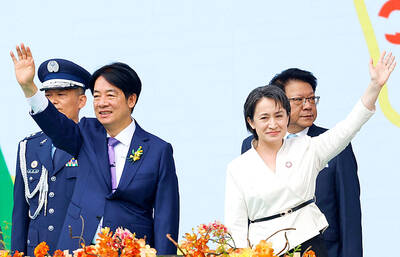The Pentagon has approved the sale of 60 F-35 Joint Strike Fighters or 60 F-15 Silent Eagle aircraft to South Korea, as tensions on the Korean Peninsula continue to mount.
“This sale only underscores the hypocrisy of continuing to deny Taiwan replacement F-16s for its soon-to-be-retired F-5s and Mirage 2000s,” US-Taiwan Business Council president Rupert Hammond-Chambers told the Taipei Times.
“The threats the [South] Korean air force face are the same as those of Taiwan’s air force,” he said.
Hammond-Chambers said that South Korea faced a surprise attack from North Korean missiles, artillery and aircraft and possibly a retaliatory attack from the People’s Liberation Army (PLA) Air Force and its Second Artillery if China weighed in to support Pyongyang.
One argument used by opponents of selling F-16s to Taiwan is that China could easily ground them by staging a massive missile attack on the nation’s military runways.
However, Hammond-Chambers said exactly the same argument could be used for not selling advanced fighters to South Korea.
“Attacks on South Korean airfields as well as US bases could well be [a] surprise and massive and yet we’ve just forward deployed F-22s too,” he said.
A final decision by Seoul on which plane to buy is expected later this year after the completion of a competition between the two US planes and the Eurofighter Typhoon.
The estimated cost of 60 Lockheed Martin Corp F-35 Joint Strike Fighter conventional take-off and landing (CTOL) aircraft and associated equipment, parts, training and logistical support would be US$10.8 billion.
Boeing’s F-15 or the Eurofighter Typhoon would cost less.
Lockheed said its F-35 would give South Korea all-aspect stealth with the most advanced avionics ever integrated into a fighter aircraft providing a quantum leap in capability over all fourth-generation aircraft.
Boeing said it was confident the F-15 was best suited to Seoul’s requirements.
Reuters reported that many analysts expect South Korea to follow Japan and buy the F-35. Singapore may order about a dozen F-35s later this month and Australia is helping to fund their development.
The US Department of Defense’s approval of the sale of either the F-35s or the F-15s came as the Wall Street Journal reported that South Korea was pressing US President Barack Obama’s administration for permission to produce its own nuclear fuel.
Nonproliferation experts said that was a move that could trigger a wider nuclear arms race in North Asia and the Middle East.
“South Korea’s government has reassured Washington during the negotiations that it isn’t seeking to develop the ability to build nuclear weapons,” the Journal said.
However, the paper said that US lawmakers were concerned that the technologies Seoul was seeking — the ability to enrich uranium and reprocess spent nuclear reactor fuel — would provide it with the key technologies needed to produce the fissile materials for a bomb.
“That capacity could further inflame tensions between the Koreas and risk sparking a broader arms race in Northeast Asia, potentially including Japan and Taiwan,” the newspaper said.
Richard Fisher, a senior fellow in Asian military affairs at the International Assessment and Strategy Center in Alexandria, Virgina, said that in announcing the future sales of fighter aircraft to South Korea, the Obama administration was trying to signal its resolve in the face of Pyongyang’s threats.
However, sales of new fighters to South Korea will not affect the balance of power until 2020 or after and South Korean and wider Asian interest in nuclear weapons has been driven mainly by US nuclear reductions in the face of China’s and North Korea’s nuclear buildup, he said.
Washington’s decision to dismantle nuclear armed Tomahawk cruise missiles unilaterally eliminated the only secure US tactical nuclear strike option to deter North Korea, “so it is no surprise that South Korea now may be seeking its own nuclear weapons,” Fisher said.
Fisher said that if Washington really wanted to affect Chinese behavior positively, it should also move to offer Taiwan a package of 50 to 60 F-35B short take-off fighters.
“Only then will Beijing come to realize the real cost of its blatant assistance to North Korea’s new KN-08 intercontinental ballistic missile aimed primarily at the US,” he said.
“Taiwan clearly requires the F-35B to better survive China’s emerging fifth-generation fighters and sales announcements for Taiwan in addition to South Korea will provide a much needed boost in confidence for the F-35 program,” Fisher said.

The Executive Yuan yesterday announced that registration for a one-time universal NT$10,000 cash handout to help people in Taiwan survive US tariffs and inflation would start on Nov. 5, with payouts available as early as Nov. 12. Who is eligible for the handout? Registered Taiwanese nationals are eligible, including those born in Taiwan before April 30 next year with a birth certificate. Non-registered nationals with residence permits, foreign permanent residents and foreign spouses of Taiwanese citizens with residence permits also qualify for the handouts. For people who meet the eligibility requirements, but passed away between yesterday and April 30 next year, surviving family members

The German city of Hamburg on Oct. 14 named a bridge “Kaohsiung-Brucke” after the Taiwanese city of Kaohsiung. The footbridge, formerly known as F566, is to the east of the Speicherstadt, the world’s largest warehouse district, and connects the Dar-es-Salaam-Platz to the Brooktorpromenade near the Port of Hamburg on the Elbe River. Timo Fischer, a Free Democratic Party member of the Hamburg-Mitte District Assembly, in May last year proposed the name change with support from members of the Social Democratic Party and the Christian Democratic Union. Kaohsiung and Hamburg in 1999 inked a sister city agreement, but despite more than a quarter-century of

Taiwanese officials are courting podcasters and influencers aligned with US President Donald Trump as they grow more worried the US leader could undermine Taiwanese interests in talks with China, people familiar with the matter said. Trump has said Taiwan would likely be on the agenda when he is expected to meet Chinese President Xi Jinping (習近平) next week in a bid to resolve persistent trade tensions. China has asked the White House to officially declare it “opposes” Taiwanese independence, Bloomberg reported last month, a concession that would mark a major diplomatic win for Beijing. President William Lai (賴清德) and his top officials

‘ONE CHINA’: A statement that Berlin decides its own China policy did not seem to sit well with Beijing, which offered only one meeting with the German official German Minister for Foreign Affairs Johann Wadephul’s trip to China has been canceled, a spokesperson for his ministry said yesterday, amid rising tensions between the two nations, including over Taiwan. Wadephul had planned to address Chinese curbs on rare earths during his visit, but his comments about Berlin deciding on the “design” of its “one China” policy ahead of the trip appear to have rankled China. Asked about Wadephul’s comments, Chinese Ministry of Foreign Affairs spokesman Guo Jiakun (郭嘉昆) said the “one China principle” has “no room for any self-definition.” In the interview published on Thursday, Wadephul said he would urge China to